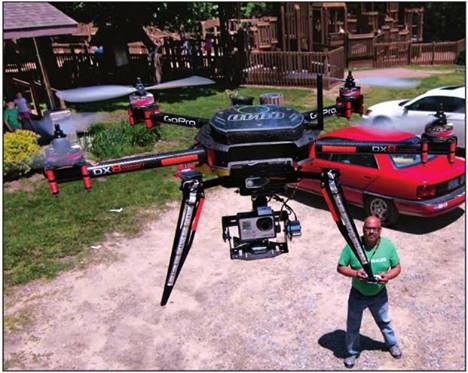
The Hovershots team flies one of their unmanned vehicles. (Photo: Hovershots APV)
The jury is still out on regulations for unmanned aircraft, but that’s not stopping a Michigan business from using them commercially.
Hovershots Aerial Photography and Video (APV) uses remote controlled helicopters — popularly known as drones – to capture video footage that is otherwise inaccessible or extremely expensive.
Owner Kevin Haley, 50, from Linden near Flint, has more than 25 years experience with remote controlled systems. But in the past he has only had access to shoddy cameras to attach to them.
So when Haley, a health and nutrition store owner, began researching drones and state-of-the-art cameras, he saw an incredible business opportunity, Haley said.
The research began in January of 2013. By April he was sold. Haley brought his 21-year-old son, Brandon Haley, on board to be the business’s creative director as he had more than six years of experience with graphic art.
The father has the experience to handle and maintain the drones, the son uses his knack for visuals to direct him to good shots. Brandon Haley also puts together and edits video packages for clients
The business launched in April and instantly found a customer.
“When hired right away I knew it would be a viable business,” Haley said.
The first assignment was a six-minute video showcasing the Shiawassee River for three neighboring communities sharing the river: Linden, Fenton and Holly. The project was shot for the Michigan Municipal League Community Excellence Award and the communities now use it to promote their areas, Haley said.
Hovershots APV services a variety of customers. Other clients have included real-estate agents and marathon organizers, like the Crim Race in Flint. The company’s drones captured aerial footage of thousands of runners.

Flint’s Crim Race featuring 60,000 people. Photographed by Hovershots AVP
The drone is the company’s calling card, but the real service comes from the finished product, oftentimes a video, Haley said.
One instance, however, where photography was the main purpose, has resulted in a Hovershots APV picture making it into the Guinness Book of World Records, Haley said.
Hovershots APV shot pictures from their drone for a record-breaking 2,099 kayaks in a flotilla, which is where all kayaks or their operators are touching in some form, Haley said. Guinness confirmed Nov. 20 that it beat the previous record of 1,902, set in 2011 at Inlet Lake, N.Y.
Haley said he contacted Suttons Bay school officials when he found out there was going to be a second attempt August 31 at the record. He was hired to photograph the event from the air.
This shot, as well as many others done by Hovershots APV, was taken by the three-pound SteadiDrone QU4D RTF. That is a drone with four rotors retailing around $1600. Haley said he prefers this drone because it folds up quickly and easily, which allows for convenient and timely set-up when they are on location.
Other features that set this drone apart are the attached gimbal system, which allows for full control of the camera while in flight, and GPS, which allows for a predetermined flight path guided by satellites, Haley said.
This use of the SteadiDrone has allowed Hovershots APV to operate ahead of the curve, taking financial advantage of a technology hasn’t yet reached full stride in America, he said.
“This is expected to be a $14 billion business in the next few years.”
Regulatory hurdles remain.
Exchanging money for the services of a drone for civilian use is illegal now. Congress has ordered the Federal Aviation Administration to come up with a regulatory system for the budding industry by 2015.
Hovershots APV offers the aerial photography to clients for free, Haley said. The customer pays for the labor and editing process.
“This is a fairly common pattern among commercial drone operators in the US,” Matthew Schroyer, founder of dronejournalism.org, wrote in an email.
Schroyer’s organization is exploring the potential for using drones in journalism. He said Hovershots APV might not be in the clear.
“The problem is their commercial service and the aerial photos they are providing are one in the same, so I doubt this tactic would stand up in court,” he wrote.
The Federal Aviation Administration (FAA) doesn’t restrict hobbyists who fly below 400 feet, Schroyer said.
Haley wants to buy a new drone that will fly longer and hold more weight, enabling the use of a better camera. He will most likely wait until new battery technology allows drones to fly up to twice as long as they do now, he said.
His current system averages nine minutes of flight time.

Knowing the remaining battery life on a drone is key, especially when operating over water. (Photo: Hovershots APV)
“Longer battery life, that’s what everyone is looking for in their system,” Haley said. “Drones are really good right now, but if we could get battery life, that would be awesome.”
The future of drone technology is uncertain, but Haley says he believes drones will be seen everywhere, performing menial tasks, sooner rather than later. Some of these tasks could include conducting traffic reports, surveying land and filming sporting events.
Drones are already being used in Africa to assist farmers in determining where the best soil is and where the best spots for water drainage, and to track elephant and rhinoceros poachers, Haley said. In Australia, a drone has delivered pizzas, a publicity stunt that could become reality before too long, Haley said.
Haley said he expects the FAA to allow the widespread use of drones in America.
“I don’t think the U.S. wants to get left behind,” Haley said.
Some drone manufacturers, such as DJI, have moved their operations from overseas to America in anticipation of the FAA’s ruling. This company, now based in Texas, wants to get a drone in everybody’s hands, Haley said.
Until there are more concrete laws, Kevin and Brandon Haley will continue to do what they love and bring people the satisfaction of a quality production that features aerial footage.
“If you can mix what you like to do in a business format,” Haley said. “That works out.”